Submachine gun ERMA EMP 36 - half a step before the MP 38 / 40
One of those designers who was engaged in the development of new submachine guns was the talented gunsmith Heinrich Folmer. In the period from 1925 to 1930, he managed to create several fairly successful samples of such weapons. In 1930, the German company ERMA (Erfurter Maschinenfabrik) bought out all the rights to the weapons created by Volmer. And soon the Nazis came to power in Germany, after which new submachine guns began to be developed for the needs of the army. So in the middle of 1930's, ERMA converted the EMP submachine gun into an EMP 36 model, which became an intermediate option between the EMP and MP 38 models.
Immediately after the acquisition of rights to weapons, the company began mass production of Volmer’s submachine guns. The engineers of the company “restored” the cooling covers on them, but otherwise the design of the pistol-machine guns remained almost unchanged. After the purchase of weapons received a new designation EMP (Erma Maschinenpistole). Beginning with the 1932 year, these models were offered for sale domestically as well as to third countries. In this case, the company tried to adapt the weapon to the requirements of specific customers, for this reason, the submachine gun was produced in several basic versions. They differed from each other mainly by the barrel length, caliber, the type of sight used, and the presence or absence of a fuse.
Experts highlight today three basic versions of EMP submachine guns. The first is with an 30 cm barrel, a bayonet attachment unit and a tangential type sight. These submachine guns were delivered by Germany to the countries of Central and Eastern Europe, in particular to Yugoslavia and Bulgaria. The second model was the most massive and was considered standard. The barrel length was 25 cm, the bayonet mount was absent, on some models a simplified L-shaped sight was mounted, on others a tangential type sight. Most often, these submachine guns were equipped with a fuse. The third variant of the EMP was distinguished by the presence of a butt-like MP-18.1 submachine gun.
It is worth noting that the guns of the company "Erma" had a commercial success in the market. Of course, it was difficult to call it significant, but it was not worth it to underestimate. A total of at least 10 thousand EMP submachine guns were produced in Germany, but the exact volume of their release has not been established yet. A batch of these submachine guns in 1936 was purchased by the SS, who used these weapons throughout World War II.
In early 1936, the German Arms Directorate submitted a report to the Wehrmacht High Command on the status and development prospects of submachine guns. The report contained conclusions about the need for arming with such weapons the technical branches of the armed forces and partially infantry. Based on these recommendations, the task was to create individual automatic weapons for crews tanks and armored personnel carriers, which would use submachine guns for self-defense in case of emergency evacuation from equipment. The weapons had to be developed with amendments to the fact that it would be used in the cramped conditions of the fighting compartment of tanks and armored vehicles.
In the same year, Dr. Berthold Heipel, the director of the arms company ERMA, initiated the design of the required weapons based on the samples already produced by the company. For the original model, he took a fairly well-mastered submachine gun EMP. When working, the designers proceeded from the future specificity of the use of such weapons by the crews of armored vehicles: most often the shooting would be of a forced nature. This predetermined a number of structural elements of the new submachine gun. In particular, the idea of a folding butt was first implemented in it, the barrel cover was removed, and for ease of firing from the tank, the reloading handle moved to the left side of the bolt box, and a special device appeared on the barrel - a support hook that was needed to securely attach the gun gun in the embrasure of an armored vehicle. It is worth noting a truly revolutionary technology for the production of basic parts of a new weapon: instead of the traditional machine-tool processing, a qualitatively new method of cold stamping parts from a thin steel sheet was used. Prior to this, this method was used mainly only in the automotive industry. The use of stamping has significantly reduced labor costs and, as a consequence, the cost of a submachine gun. German designers of ERMA managed to create a unique design that had a direct impact on the entire future evolution of this type of small arms.
The new 9-mm submachine gun received the official designation EMP 36 and was designed to fight the enemy's manpower at a distance of up to 200 meters. The submachine gun EMP 36 consisted of a barrel with a bolt box; gate with a hammer, connected together with the details of the return mechanism (moving system); forend with folding butt, trigger box, trigger and box magazine. The use of the folding metal stock of the original design made it possible to reduce the length of the weapon from 831 mm (folded butt) to 620 mm (folded butt). Also on this model appeared pistol grip fire.
In the submachine gun EMP 36 was implemented a new design solution for the store neck, which was moved down, however, not strictly vertically to the barrel of the weapon, but with a slight shift to the left side. Such an approach finally allowed to overcome the old lack of German-developed submachine guns, which was associated with the lateral arrangement of stores. The transfer of the center of gravity to the plane of symmetry of the submachine gun immediately had a very positive effect on the accuracy of the firing of the weapon, regardless of the emptying of the magazine, especially if the shooter fired continuous fire. A box shop on the 32 cartridge was created specifically for this model, which differed from the previously produced stores in a number of parts.
Automatic machine gun EMP 36 worked on the principle of recoil free shutter. On this model, a shock mechanism of a shock type was used; it worked from a reciprocating combat spring. The trigger mechanism was almost unchanged from the EMP model. The weapon had a translator of the type of fire. His button was placed above the pistol grip. The only fuse of the submachine gun was the cranked notch on the bolt box, where the reloading handle of the weapon was wound up when retracted to the rearmost position. Return-combat spring, as in the model of an EMP submachine gun, was enclosed in guide telescopic tubes. The buffer spring contained a buffer spring, which, together with a relatively large (738 grams) mass of moving parts (impactor, bolt and return mechanism), free shutter release at the moment of firing and a long automatic stroke, allowed the rate of firing to be reduced to 350-400 per minute.
For the EMP 36 model, the weapon maintenance process has been greatly simplified. Now, to disassemble the submachine gun instead of pushing the lever protruding from the trigger guard and separating the bolt box from the butt, which was not very convenient in the EMP model, it was only necessary to pull the retaining bolt back, turning it to 1 / 4 turn, and when the trigger was pressed to separate the barrel with the bolt box and the moving parts of the automatic submachine gun from the box with the trigger mechanism and a folding metal butt.
Already after the start of mass production, it turned out that the pressed parts were still not reliable enough. Then, when the head of ERMA, Berthold Geipel, received an official order from the Wehrmacht Arms Administration to develop a new submachine gun for paratroopers, tank crews and policemen, he had to return to the technology of machining the main parts of the weapon again. Between 1936 and 1938, the EMP 36 submachine gun was developed in the MP 38. This model submachine gun was officially adopted by the 29 June 1938, becoming a truly mass model of small arms and one of the symbols of the Second World War.
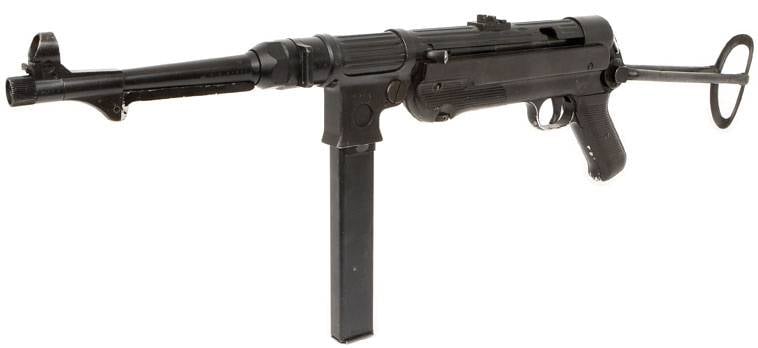
For its time, the MP 38 submachine gun had a revolutionary design. Wooden parts were not used in its construction. The lack of a wooden butt not only made it more convenient for paratroopers and tankers, but also easier. The tree was not used at all at the release of the MP 38 submachine guns, only metal and plastic, which was first used in the design of submachine pistols.
Performance characteristics of EMP-36:
Caliber - 9 mm.
Cartridge - 9x19 mm Parabellum.
Overall length - 831 mm.
Length with folded butt - 620 mm.
Barrel length - 250 mm.
Weight without cartridges - 3,96 kg.
Shop - box on the cartridge 32.
The initial speed of the bullet - 360 m / s.
The rate of fire - up to 350-400 vyst / min.
Sighting range of shooting - 200 m.
Information sources:
http://zonwar.ru/pp/mp_36.html
http://militaryarms.ru/oruzhie/pulemety/mp-38-i-mp-40
http://war-arms.info/strelkovoe-oruzhie/pistoleti-pulemeti-i-avtomati/germaniya/erma/pistolet-pulemet-erma-mp-36.html
Open source materials

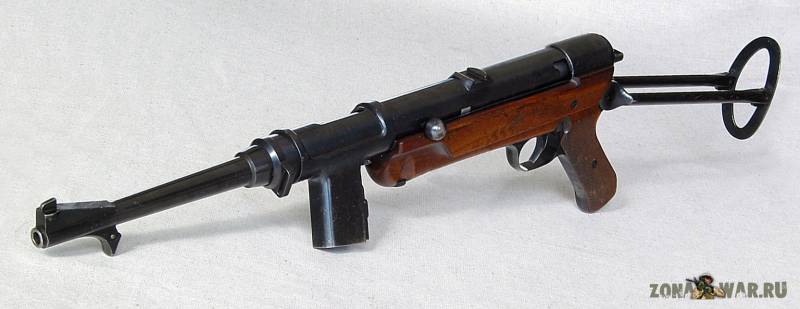
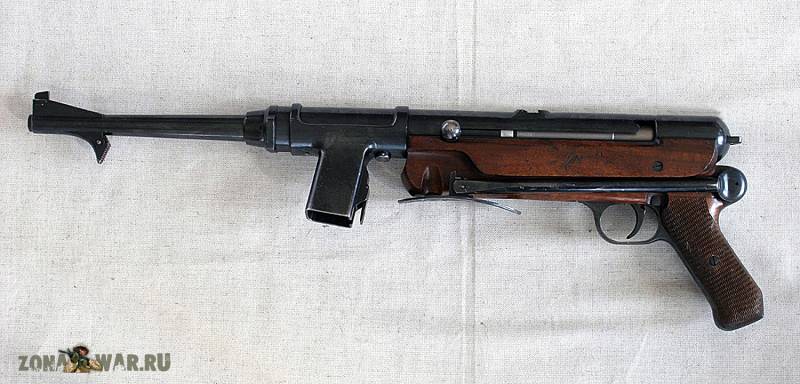
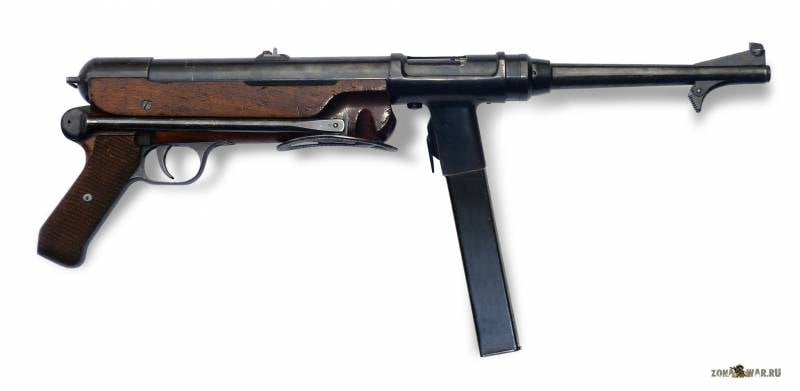
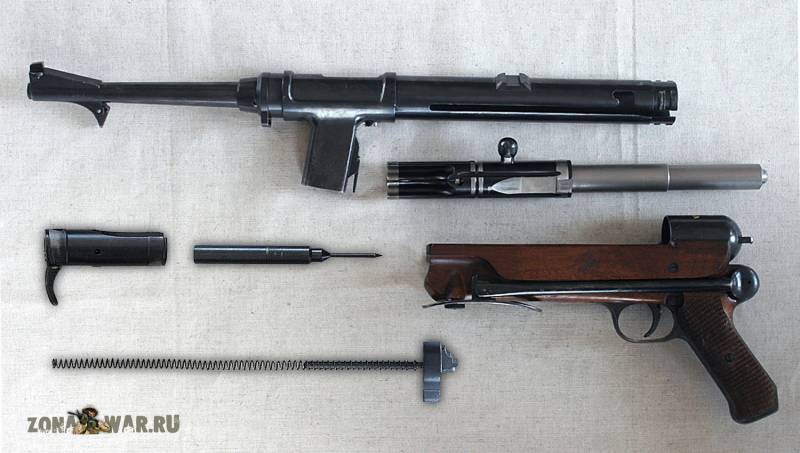
Information